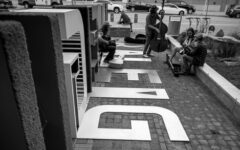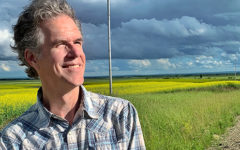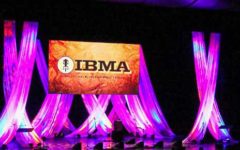
Ask Sonny Anything is a recurring feature where our readers pose questions to the great Sonny Osborne, one half of the iconic Osborne Brothers who redefined bluegrass music in the 1960s, and noted banjo maven and collector of fine prewar instruments. Everyone is encouraged to pose queries of your own each week in the comments, about his history in the music, his wealth of banjo knowledge, or regarding any life advice you might be needing.
Sonny, The Osborne Bros have had so many great songs and albums. I m a very big fan of your music and The Chief banjo. Can you tell us how you guys came up with the Bluegrass Classic album? To me it’s the best bluegrass collection ever recorded. Also, was that the first recording with your Granada? And if you don’t mind, could you share the story about the cows in VA?
– Mark K.
First of all Mark…Evidently you were there, had to be. Wytheville VA, or maybe Lebanon, VA we were on stage about 15 minutes into our show. We started into Kentucky… Bobby, Dale, and I ganged around the mic and sang K E N T U C K Y….sounded good. One second later, before we could get into the second line. This herd of about 8-10 cows came charging over the hill…right center field…a small herd of cows and ONE BULL. ONE BULL….they stopped and we were dumbfounded… just stood there laughing and we pointed it out to the crowd what we were laughing at. The whole crowd turned and looked and half of them stood and looked. Evidently the bull took this opportunity to perform for the folks and that is just what he did, and I might add, he gave a stellar performance, one to be proud of. When his act was over, the herd turned around and went back to where they came from. The bull stumbled along behind them…. Only the truth folks. That is the truth.
Mark, I think you are referring to the Bluegrass Collection album that we did for CMH record Co. We did half of an album of Flatt/Scruggs type songs in the ’60s and it was successful, so we thought it was time to do another one. We called Benny Birchfield to come sing with us, and I thought it turned out rather well. Benny could do those part changes as good, if not better than anyone. Bob Moore played bass, Blaine Sprouse and Kenny Baker played fiddles, Robby Osborne played snare drum, Ray Edenton played rhythm guitar, and I’m probably leaving someone out. That was the first recording I made with the Granada banjo. It performed like the aforementioned bull… stellar! All the way. Thanks for participating in this free for all. S
—–
Sonny,
like you I was totally wrapped up with Earl when I started playing in the early 1960s, and I would like to ask you for your take on how Earl influenced the development of 3-finger style. We know that Earl did not create the 3-finger style, but drew on the picking of other players in North Carolina, many of whom he credited for inspiring him. To my ear, however, those earlier players relied mostly on the forward roll, and this seriously limited the fluidity and flexibility of their playing. I have long assumed that one of Earl’s brilliant contributions was to add the backward roll, which profoundly changed the dynamics of the North Carolina 3-finger style, and made it possible for people like me to learn how to play it. Does this jibe with your assessment of Earl’s influence?
Michael C.
Michael. After studying Earl for so long I’m rather convinced that Earl started out playing the backward roll. Then switched to the forward. Two things prove it to an extent. On the Mercury record of Roll In My Sweet Baby’s Arms, during his last banjo break when he goes to the 4 chord, he switches to the backward roll for that 4 chord. If you listen closely, he actually picks up speed. Most players that I know start out doing the forward roll so they have a problem going to the backward roll at that speed. He certainly didn’t. He actually sounded more at home doing that roll. If you’re a player you know what I’m talking about, if not you will think I’m headstruck. He told me that when he was a kid he was sitting on the porch playing Reuben and Junie came walking up the road and when he heard Earl playing he stopped and “cocked his head up”… Earl said, “I knowed I had something right then.” I thought that he either discovered the forward or backward roll. Finding either one would make a world of difference. Do you agree? The roll, either one would change the ball game. To me Earl’s most brilliant influence was playing the melody, word for word. It was easy to understand what he was playing.
Thank you for participating.
s
—–
Sonny,
First of all, I wholeheartedly enjoy the Ask Sonny Anything column. I look forward to it all week! I am huge fan of bluegrass music, but, I am just as much a fan of stories about people in the business through the years. I didn’t have the opportunity to see some of the 1st generation bluegrass performers, so these stories are priceless to me. Now, for my question. I have heard many Bill Monroe stories through the years. What is your favorite Bill Monroe story/memory?
– Mason Jar
Bill Monroe was 41-43 years old when I was a member of his Blue Grass Boys. A man goes through changes from his 40s to 70s, as did Bill. He was all serious when I was there as opposed to later in life, and unfortunately his later years was when his most quirky time was. Glen Duncan and Dana Cupp can tell you some unbelievable things that happened. True, they told them to us when they were members of our band, but I dare not repeat them for fear of getting the facts wrong. That would not be good. I believe I was there, and the cause of one of his meaningful sayings. “THAT AIN’T NO PART OF NOTHING” started in Arlington, VA. We had already finished our show and I had changed clothes and come back in the theater to watch Bill’s show. I was sitting in the total back of the place so there was no way he could see me. At a point in his show he asked for requests from the audience and people just yelled them out. So, I joined in by screaming, “Take Me Back To Tulsa” and Bill made no remark, it was like he didn’t hear me. They played a song requested, and when done asked for more. So I screamed as loud as I could “Take Me Back To Tulsa” again. This happened three times. The last time I was the only request he had, so he couldn’t ignore me, as he had done thee times already. So he looked at Kenny Baker and said; “AH KENNY DO YOU KNOW THAT NUMBER?” Kenny said No. And with that Bill said, almost inaudibly, “AH, WE DON’T DO THAT NUMBER”….that number ain’t no part of nothin’ “….and with that he went right on with the show. This happened in the late ’60s.
Going back to 1952, Bill didn’t have a set list, so we didn’t know what he was going to do from one song to the next. But at the end of each song, he would strike a chord on the mandolin. Jimmy Martin, who was Bill’s guitar player at the time, told me that would most likely be the key to the next song and we had to prepare our capos for that key. When he announced the title, if you were to do the intro, you had best be ready. If you weren’t, he would just stand there and stare at you and sometimes say; “LESS GO BOY”….that was 67 years ago. Sometimes I miss it, and sometimes I don’t, but I’m glad I was there. I don’t honestly know why I was there, but fact is, I was. I have the proof of that fact…I recorded 9 tunes with Bill Monroe and The Blue Grass Boys.
S
—–
Sonny, we’ve discussed this subject before but I’m surprised no one else has asked: The 6-string banjo (Not a guitar-banjo, but a 5-string with an added lower string). JD Crowe experimented with it a little in the early ’70s. You used it quite a bit during that period too. What inspired you to try one? Why do you think none of the great banjoist of the 21st century are using it? Would you recommend it? Thanks for your time!
PS: the fiddler you described who played with the Bluegrass Cardinals was probably JB Prince from North Carolina. No one more eccentric than JB was!! Also probably one of the most accomplished fiddlers that few people know about!
– Lynwood L.
Lynwood….thank you for spending some of your time here. I appreciate it. Larry Stephenson also reminded me that it was, in fact, JB Prince. I only met him once, at Cherokee, NC festival. He was with the Cardinals at that time. He brought his fiddle over to our bus and proceeded to play some amazing Benny Martin things. I was totally impressed. Until he asked if we had a beer on the bus and lit a cigarette. I told him no, on both counts and would he please put the cigarette out. Bobby’s voice nor mine could take smoke. We had three rules on our bus in in our band. YOU DON’T DRINK, DON’T SMOKE, AND DON’T BE LATE. JB left shortly after that, maybe 5 minutes. I never saw him again. What a waste of great talent. His ruination appeared to be alcohol.
Ah, the 6 string banjo. I just got tired of needing that low note and faking my way out of it because the fourth string was not low enough. So, I called Clairman (CE) Ward and told him exactly what I wanted, and asked him could he build a 6 string neck exactly like my Sonny Osborne model Vega. He said he could, and he would need the original five string neck as a reference. I got that to him and in a few weeks it was done. This was late ’69 or very early ’70. I picked the neck up on Saturday night on our way back from Florida. Dale Sledd and I put it on he banjo and I just really adapted to it rather quickly. That Wednesday we recorded Listening to The Rain, the first tune ever to feature a 6 string banjo. Needless to say, I loved it and used it on just about everything we recorded from 1970 to 1976. It played some pretty good things and continued to perform well. I heard that JD had Rual Yarborough make one for him, ’bout ’72 I guess. I remember, we were doing the Haggard opening thing. I never talked to him about it and never heard anything he played it on. It takes some thought, a lot of serious concentration, and a whole big case of “want to” to play it successfully. The notes and chords are there and I found it pleasing to be able to play every note of a song. Banjo players of today? They don’t have time to learn the 5 string much less another string added. Takes too much time away from their video games. Hey, that’s not a putdown to anyone…The Old Indian was just funnin’ witchu! Béla Fleck, Tony Trischka would be good with that neck. The last 6 string I had, I gave it to Raymond McClain. He played it for a while as his regular banjo. I don’t know if he still uses it or not. Frank Neat made it for me.
Thanks Lynwood, it’s always good to hear from people of my time who have been here, done that!
—–
Hi Sonny, being a teenager in the ’50s I naturally liked rock & roll, especially Chuck Berry. He had some fantastic intros on some of his songs. When I discovered bluegrass, I fell in love with the intros you did, among my favorites were I’ll Be Alright Tomorrow, One Tear… stuff like that. I always thought you were to bluegrass what Chuck was to rock & roll. Also, you and Bobby and whoever else had some of the best harmonies I ever heard. I know you played banjo with Bill Monroe when you were 14, did you sing baritone back then? Thanks, for all you’ve done for bluegrass music!!
Roger A.
Roger, thanks for your participation in this free for all. I was not the best fan Chuck had, but I did like some of the things he did, and I used some of them on the banjo but they were totally disguised, and you would have a hard time finding them. One which you would recognize was at the end of my break on a song Ronnie Reno was featured on, Love’s Gonna Live Here. I listened to everything that was played by whomever, and tried to transpose it to the banjo. Sometimes it worked, sometimes it didn’t. Of course when you do that, the lick takes on a completely unrecognizable life of it’s own. I got them from piano, drums, steel, electric guitar, horns, bass, fiddle… you name it. Yes when I played banjo as a Blue Grass Boy I did sing baritone in the quartet songs, and sang baritone in the Shenandoah Valley Trio songs.
KEEP ‘EM COMIN’
S
If you have something you would like to ask Sonny, be sure to post it in the comments below, or send it to us directly.







